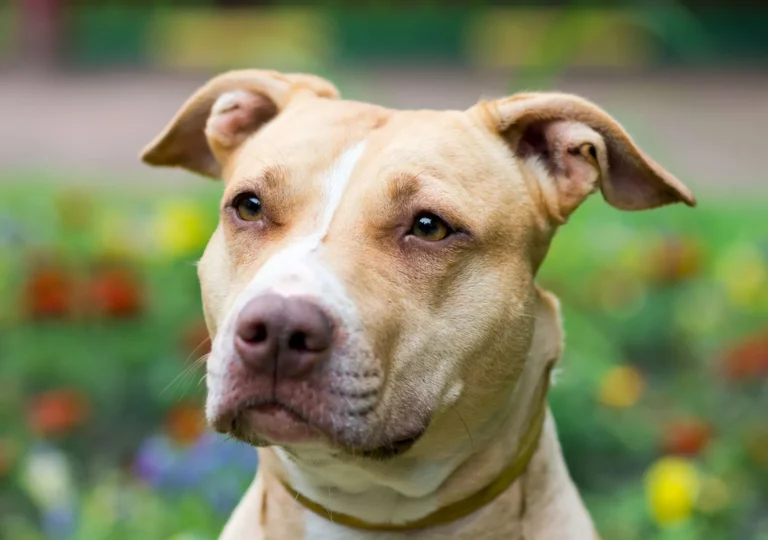American Pit Bull Terrier Temperament and Dog Breed
The American Pitbull Terrier often sparks intense discussions about dog behavior and safety. These dogs were initially bred for bull-baiting and later worked on farms, giving them a history that’s both rich and intricate. Currently, they face a battle of perception, dealing with a negative image more influenced by media stories than their actual behavior.
Supporters praise their devotion and smarts, but others worry about their potential for aggression. The reality of the American Pitbull Terrier is nuanced and calls for a closer look at their past, temperament, and how humans treat them to truly understand their role in today’s world.
This breed’s true nature is complex, and only by acknowledging their full story can we have an honest conversation about them. It’s essential to recognize the impact of how they are raised and cared for, which plays a significant role in their behavior. The American Pitbull Terrier requires a responsible owner who understands the need for proper training and socialization.
It’s not a simple issue of good or bad; it’s about understanding the breed and providing the right environment for them to thrive.
Key Takeaways
- American Pitbull Terriers spark debate on dog safety.
- Their rich history includes farm work, not just media tales.
- Responsible ownership is critical for their positive behavior.
Quick Facts
The American Pit Bull Terrier is a robust and medium-sized dog breed with an average lifespan of 12 to 14 years. These dogs are well-known for their muscular physique, weighing anywhere from 30 to 75 pounds, and have short, sleek coats that can be found in various colors.
Originating in the United States, they were once used for bull-baiting but have since become valued farm dogs and loving companions for children. The United Kennel Club’s breed standard highlights their strength, agility, confident nature, and love for life.
Despite facing legislative challenges in some areas due to their controversial reputation, American Pit Bull Terriers are still highly sought after for their adaptable and friendly temperament. To keep the breed healthy, it’s vital to watch for conditions like hip dysplasia and to commit to responsible breeding.
Overview
Building on the essential traits of the American Pit Bull Terrier, this overview aims to give a clearer understanding of the breed. It looks at its history, physical features, and how it fits into today’s world.
The breed’s history begins in England and is closely related to the Staffordshire Bull Terrier. The American Pit Bull Terrier established its presence in the United States in the late 19th century. Recognized by the United Kennel Club and the American Dog Breeders Association, the breed’s physicality is robust and medium in size. They are known for their glossy, smooth, short coat that comes in various colors and typically lasts 8 to 15 years.
Despite a past marred by association with bloodsports, American Pit Bull Terriers have become exemplary in dog sports, search and rescue, police work, and as loyal service animals. However, they face challenges due to breed-specific legislation and how the public perceives them.
American Pit Bull Terrier Dog Breed Pictures
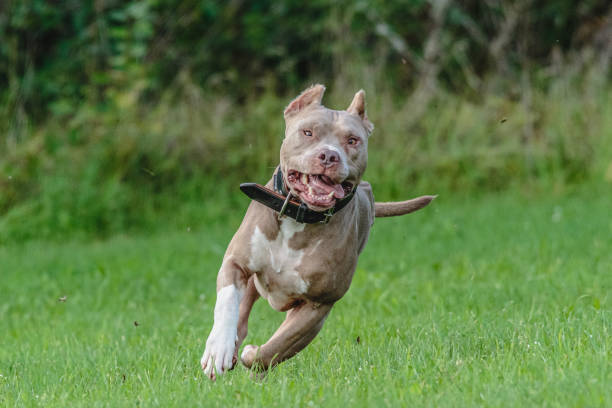
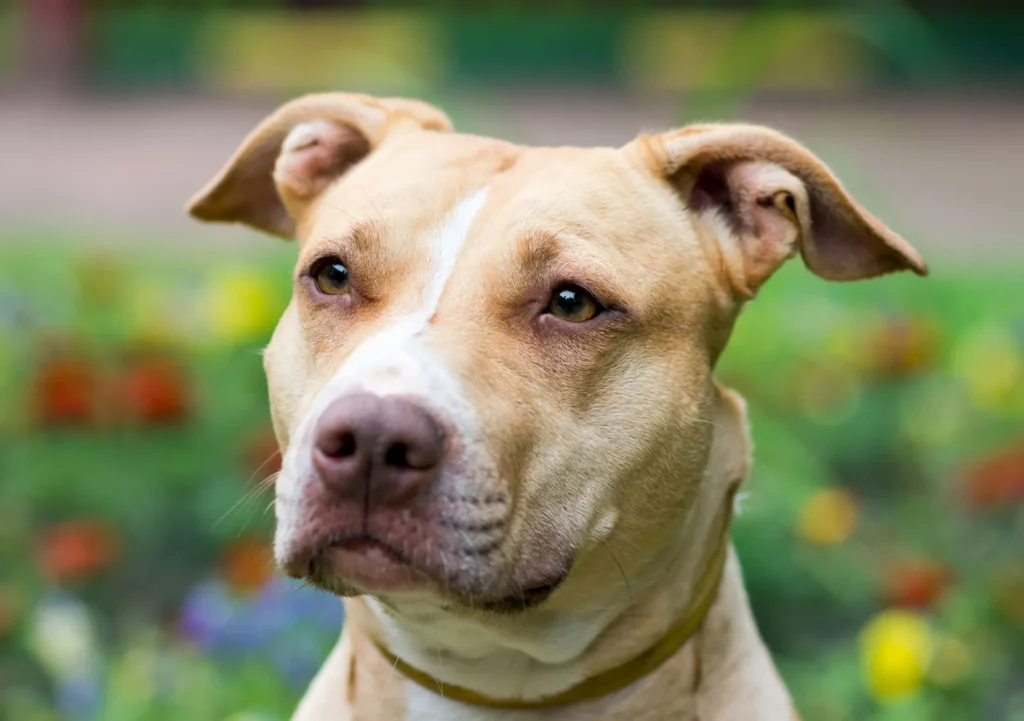
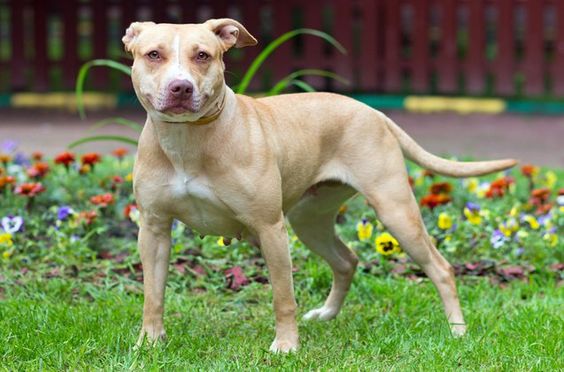
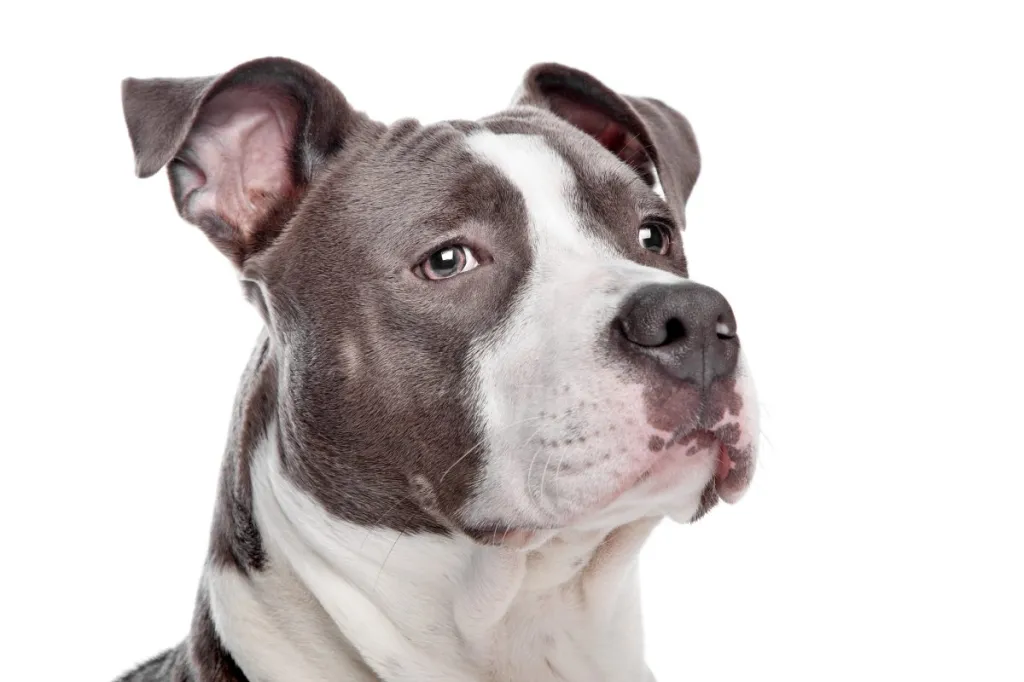
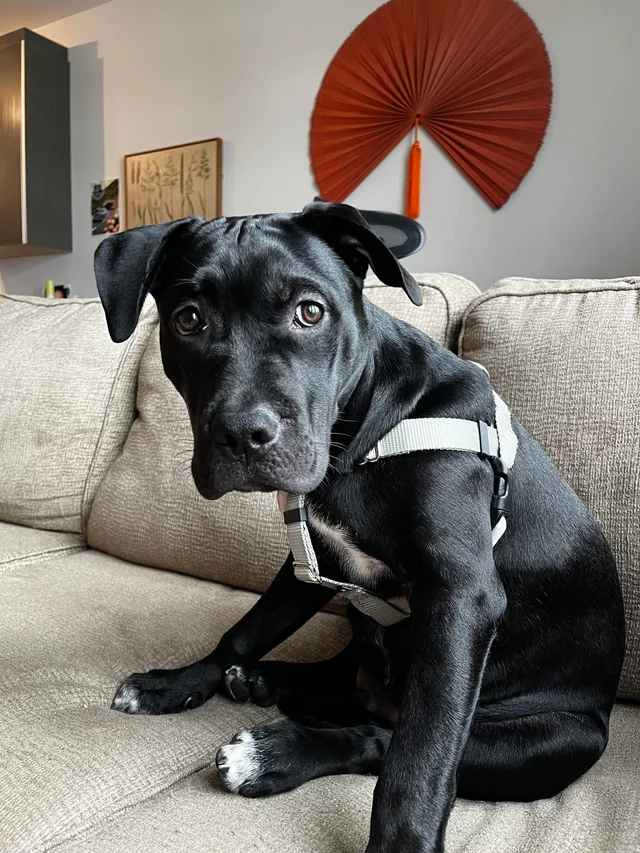
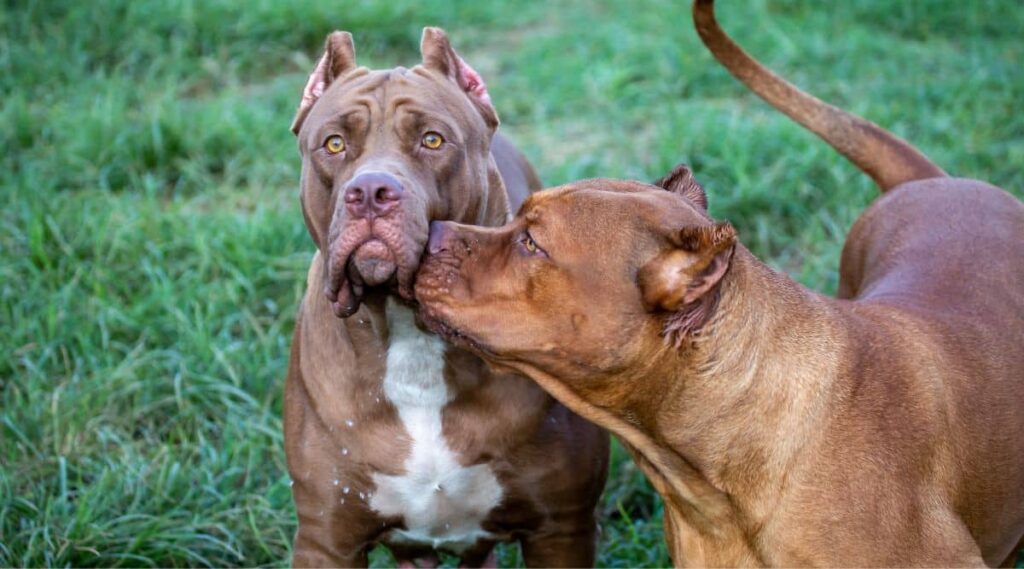
Key Traits and Characteristics of the American Pit Bull Terrier
American Pit Bull Terriers are known for their strength, confidence, and zest for life. These traits make them stand out in their physical form and character among dog breeds. Medium in size, these dogs are powerful and athletic, perfect for those who want a sturdy sidekick. Their intelligence is impressive, and they love to make their owners happy, so they usually respond well to training.
If you have kids, these dogs can be significant since they’re known to be gentle and devoted to their families. But remember, because of their robust nature and a tendency to be wary of other dogs, it’s crucial to introduce them to various people and pets early on. You’ll also want to keep up with their training regularly.
Trait Chart:
| Trait | Description | Considerations |
|---|---|---|
| Physical Build | Medium-sized and muscular | Needs plenty of exercise |
| Coat | Short, smooth, and comes in various colors | Easy to groom, but expect some shedding |
| Temperament | Outgoing, loves kids, and aims to please | Socialize them from a young age |
| Intelligence | Smart and loves to learn | Keep their minds busy with training |
| Legislation | Some areas have restrictions on the breed | Always check your local laws before getting one |
American Pit Bull Terriers are not just any dog breed but firm, loving companions that thrive with proper care and training. They need regular physical activity to stay healthy and content. Their coats are low maintenance, but you’ll still find some hair around the house. These dogs are full of life, brilliant, and have a soft spot for children. It’s essential to teach them how to interact with other dogs and people from a young age to prevent any issues. Be aware of local laws; some places have specific rules about owning this breed.
Origins and Evolution
The American Pit Bull Terrier has a heritage that combines various breeds from the British Isles. These dogs were initially bred for their muscle and determination. The breed’s development includes:
- Ancestry that can be traced to the Old English Terrier and Bulldog breeds.
- A transformation from being used in cruel fighting sports to becoming beloved pets.
- Influential individuals from history who shaped the breed for more peaceful purposes.
These elements highlight the American Pit Bull Terrier’s progression from its earliest days to its role in modern society.
Breed Ancestral Roots
The American pit bull terrier originated in England from the now-extinct Old English terriers and bulldogs. Over time, in the late 19th century, these breeds merged to form the modern American Pit Bull Terrier lineage. Initially, these dogs were bred for intense sports like bull-baiting due to their strength, resilience, and agility. However, they were brought to the United States in the 1800s, where their role shifted to that of a working dog and a loyal pet.
Organizations such as the UKC and ADBA recognize the American Pit Bull Terrier. It is known for its medium size, sturdy build, and smooth coat. As breeders experimented with different lines, variants such as the Castillo and Colby bloodlines existed. Some of these lines were bred for their fighting prowess, while others were aimed at conforming to show standards. This highlights the need for careful breeding practices to prevent the spread of genetic health problems within the breed.
Developmental Breed History
Originating from the harsh environment of 19th-century English bloodsports, the American Pit Bull Terrier made a remarkable transition in the United States. It changed from a fierce fighter to an adaptable working dog and loyal pet. Bred initially for the cruel sports of bull and bear baiting, the breed had to adapt when those activities were banned in 1835. Dog fighting became the new focus, engraining specific aggressive characteristics in the breed. These traits have sparked heated debates and particular laws targeting the species in various places.
The breed has been shaped by diverse ancestry, influenced by illicit dog fighting and legitimate dog shows. Selective breeding has played a critical role in preserving the breed’s physical prowess and temperament. The American Pit Bull Terrier is officially recognized by the United Kennel Club (UKC) and the American Dog Breeders Association (ADBA). The American Kennel Club (AKC) refers to the breed as the American Staffordshire Terrier, setting unique standards for it.
Notable Historical Figures
Certain American Pit Bull Terriers have significantly impacted the image and development of their breed. These dogs, which have roots in Old English Terriers and Bulldogs from England, were introduced to America in the late 1800s.
Influential figures within the breed have shaped the American Pit Bull Terrier’s complex reputation. Although the species has a history of dogfighting, organizations like the United Kennel Club (UKC) and the American Dog Breeders Association (ADBA) have acknowledged it. Still, the American Kennel Club (AKC) has not.
American Pit Bull Terriers live, on average, between 12 to 14 years and have been subjected to laws targeting specific breeds due to concerns over aggression. However, these dogs have proven their adaptability and skill across various activities, including dog sports, search and rescue, police work, and service animals.
Physical Dimensions
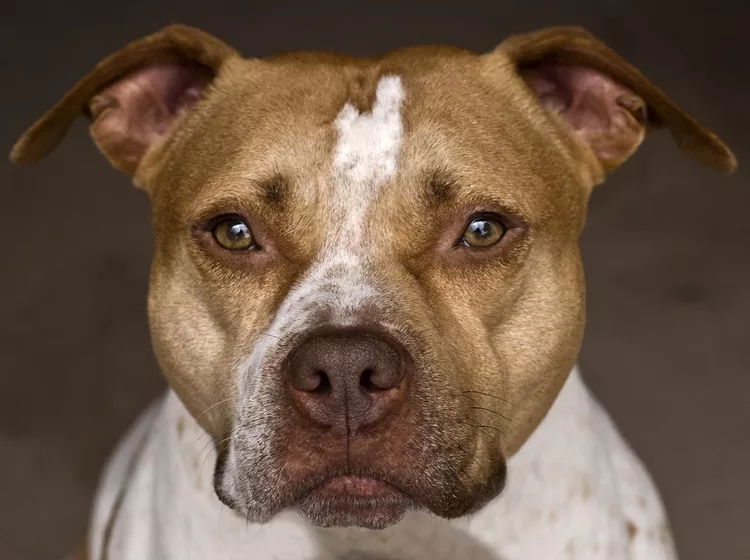
The American Pit Bull Terrier’s physique showcases its strength and active nature. Males are generally larger, showing a clear size difference between genders. Females, while smaller, still possess a sturdy build. Their physical structure is muscular, providing a balance of power and grace.
This breed’s short, sleek coat is easy to care for and contributes to their overall health. Understanding these traits helps owners meet their dogs’ needs and appreciate their abilities.
Height and Weight
Male and female American Pit Bull Terriers differ in size. Males often reach heights of 18-21 inches and weigh 35-60 pounds. Females are typically smaller, standing 17-20 inches tall and weighing 30-50 pounds. These muscular and strong dogs show their shared lineage with the Staffordshire Bull Terrier.
A healthy American Pit Bull Terrier’s weight depends on its height and body shape, with a muscular physique being standard. Keeping their weight in check is critical to their well-being and agility. These dogs must maintain a balanced weight relative to their height to stay healthy and energetic.
Body Structure
The American Pit Bull Terrier is known for its strong and athletic form. This dog has a distinct look with a broad skull and a wide muzzle, showcasing powerful jaws. Its body is slightly longer than tall and features a broad chest and muscular back legs. The round feet are arched, adding to their solid stance. These traits give the breed powerful movement and agility.
Owners should watch for health issues like hip dysplasia, which can impact these robust dogs despite their resilience.
Coat Texture
American Pit Bull Terriers have glossy coats showing their solid muscles and agility. Their skin is easy to care for because it’s short and doesn’t shed much. With a simple grooming routine, these dogs can look their best without much effort.
They come in many colors, like red, black, and buckskin, but you won’t find Merle among them. The smoothness of their coat highlights their athletic shape.
Color Variations
American Pit Bull Terriers are known for their distinctive coat texture and come in various colors and patterns. These features, along with their size, give them a unique look. The American Dog Breeders Association recognizes red, black, and buckskin colors among these dogs. They have a smooth coat that shows off their muscular build.
Male American Pit Bull Terriers usually weigh between 35 and 60 pounds and are 18 to 21 inches tall. Female dogs are a bit lighter, weighing 30-50 pounds and standing 17-21 inches tall.
These details are essential for breeders and dog lovers to understand and value the breed’s uniqueness, along with that of its close cousin, the American Staffordshire Terrier.
Tail Characteristics
The American Pit Bull Terrier has a distinctive tail, contributing to its unique outline. It’s short, begins low on the body, and narrows to a sharp point. This tail is a seamless continuation of the dog’s backline and is a trademark of the breed.
At rest, the tail hangs down and reaches the hock. When the dog moves, the bottom becomes an extension of the spine, showcasing the breed’s athleticism and poise. If a dog’s tail curls over its back, it doesn’t meet the breed’s standard and is seen as a fault.
Understanding these tail traits is crucial for judging if an American Terrier meets the breed’s expectations and is part of the overall appearance of the Pit Bull Terrier.
American Pit Bull Terrier Temperament and Behavioral Traits
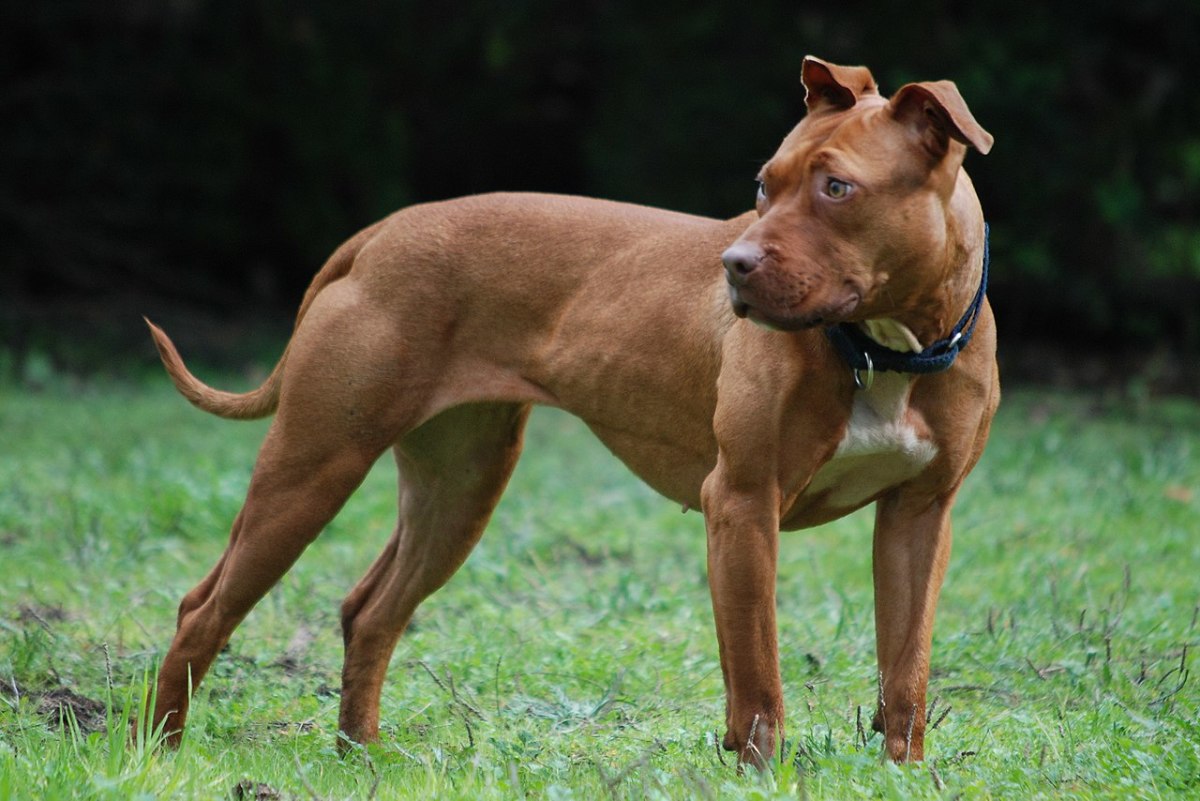
The American Pitbull Terrier exhibits various behaviors shaped by their upbringing, their genetic makeup, and how they interact with their environment. Introducing them to different situations and other dogs early on is vital to prevent aggressive tendencies from developing.
Considering their strong hunting instincts, teaching them to get along with different animals is also essential.
For these dogs to thrive, they need intelligent training methods that play to their smarts and willingness to learn. Myths about them being naturally aggressive need to be set aside.
These factors are crucial to being a good dog owner and helping these dogs become well-rounded pets.
Socialization Importance
Socialization is critical for American Pitbull Terriers, as it shapes their behavior and helps them interact well with humans and other animals. Starting training and socialization early is essential to prevent aggression and teach them how to behave. These energetic dogs do best when they have a variety of experiences and meet different people and animals. This helps them grow up confident and able to handle various situations.
Socializing these dogs as they grow helps them stay friendly and polite. This makes them great family pets and community members. They can be perfect around children if they’ve been properly socialized. It’s about allowing them to learn and become used to various life scenarios.
Prey Drive Management
Training American Pitbull Terriers involves more than just primary socialization. It’s essential to manage their prey drive to prevent hunting behaviors. The American Kennel Club emphasizes this as part of being a responsible owner of such a breed.
Known for their strength and resolve, these dogs need regular training. This helps them positively use their instincts. Owners should use obedience training and exercises that teach impulse control. This can help control a strong prey drive.
Mental stimulation is also crucial. It can involve things like puzzle toys that keep their minds active. With steady training, an American Pitbull Terrier will focus on positive tasks instead of chasing potential prey.
This helps maintain a stable temperament and avoids predatory behavior at home.
Training Techniques
Practical training methods for American Pit Bull Terriers focus on their eagerness to please their owners. Positive reinforcement like treats and verbal compliments is vital in teaching obedience and encouraging good behavior. This approach also helps to strengthen the bond between the dog and their human companion.
It’s essential to begin socializing these dogs early. Introducing them to different places and people helps prevent aggression and makes them more adaptable to new situations.
Including activities that challenge their minds and bodies for behavioral training is beneficial. This could involve agility courses or puzzle toys that keep them engaged and use up their energy.
Being a consistent leader for your dog and setting clear rules is essential. This helps build a trusting relationship and teaches them discipline. Professional training classes can be beneficial for addressing behavioral problems early on. This ensures the American Pit Bull Terrier becomes a friendly and well-behaved companion.
Aggression Myths Debunked
Many people mistakenly think that American Pit Bull Terriers are naturally prone to aggression, but their behavior is largely shaped by how they are raised and their environment. The label ‘pit bull’ often triggers unnecessary fear of dog aggression, but research shows the charge is not tied to any specific breed. Studies have found that a dog’s socialization, training, and personal history influence its behavior.
Laws targeting Pit Bull Terriers in some areas are based on false beliefs, not on the actual behavior of the dogs. Negative media images have also contributed to unfair stereotypes despite evidence that these depictions are often overstated. Owners must provide proper training and socialization, which can prove that these dogs are typically friendly and not aggressive by nature.
Exercise Needs
American Pit Bull Terriers are known for their energetic nature, and meeting their exercise needs is vital for their overall happiness and behavior. Regular physical activity is crucial for these dogs to stay healthy and prevent behavioral problems.
Their agility is one of their standout features, which they can showcase in activities like agility courses or interactive games. Since they’re also skilled climbers, having a secure yard with proper fencing is essential to keep them safe and prevent escape attempts.
To avoid these dogs becoming restless or destructive, providing them with daily exercise is necessary. This includes walks, runs, and activities that stimulate their minds. Engaging them in these ways promotes a peaceful life with their human families.
Wellness and Longevity Concerns of American Pit Bull Terriers
The American Pitbull Terrier is a sturdy breed but encounters some health issues, much like other dogs. These problems can affect how long and how well the dog lives.
Common Health Concerns: They can inherit conditions like hip dysplasia and cardiac issues. It’s essential to address these early to lessen their effects.
Life Expectancy Considerations: A pit bull’s lifespan can vary due to genetics and environment. They typically live between 8 to 15 years.
Preventive Health Strategies: Keeping this breed healthy involves regular vet visits, a balanced diet, and consistent exercise. These steps are essential to prevent diseases and ensure a good quality of life.
American Pit Bull Terrier Health Issues
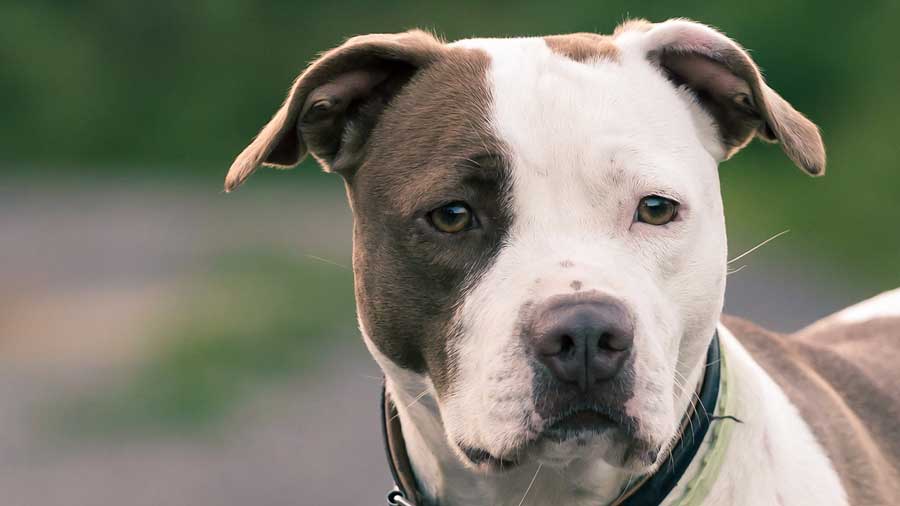
American Pitbull Terriers are solid and energetic but tend to develop health issues that owners must watch out for. Awareness of these issues and taking preventive steps is crucial in keeping these dogs healthy for as long as possible.
- Hip dysplasia is one of these inherited conditions; it can cause problems in the hip joints.
- Another serious health problem they might face is degenerative myelopathy, a disease that progressively harms their nervous system. It’s essential to monitor the signs of these conditions and maintain a routine that includes the right amount of activity.
Their short fur makes them more likely to get skin conditions like mange or allergies. That’s why keeping up with their grooming needs is so important.
- They can also have thyroid issues or be born with heart problems, so regular visits to the vet for check-ups and tests are a must.
- To prevent obesity, which can lead to other health complications, owners should ensure their Pitbulls get a balanced diet and plenty of exercise.
- Also, being alert to the signs of kneecap dislocation can help catch it early, making treatment more effective.
Lifespan Expectancy Factors
When it comes to the lifespan of American Pit Bull Terriers, we must consider various elements like genetic makeup, the care they receive, and their day-to-day living habits.
Genetic factors are crucial as they can make these dogs more susceptible to hip dysplasia, skin problems, and heart defects from birth. That’s why it’s vital to support breeders who focus on the health of their dogs’ genes.
A healthy diet, regular physical activity, and proactive medical care are vital to keeping Pit Bull Terriers in top shape. Breeders should also ensure puppies receive proper socialization and training early on, which helps set them up for a longer, healthier life.
Working closely with a vet can help create a specific plan that addresses the unique needs of this breed.
Preventative Health Measures
Taking care of the health of American Pit Bull Terriers before issues arise is critical to their overall well-being and long life. Regularly checking them by a vet is crucial because it helps catch and manage hereditary matters early on, such as hip dysplasia, degenerative myelopathy, and skin problems like mange and allergies.
Feeding them a well-balanced diet and ensuring they get plenty of exercise will keep them healthy and in shape. If you’re a dog owner, practicing responsible breeding is an intelligent move to decrease the chance of passing on genetic illnesses.
Socializing your Pit Bull and training them properly is just as important as providing physical care for their health. These steps ensure they’re not only fit but also well-adjusted companions. Regular play and exercise contribute significantly to their mental and physical health.
Maintenance Essentials
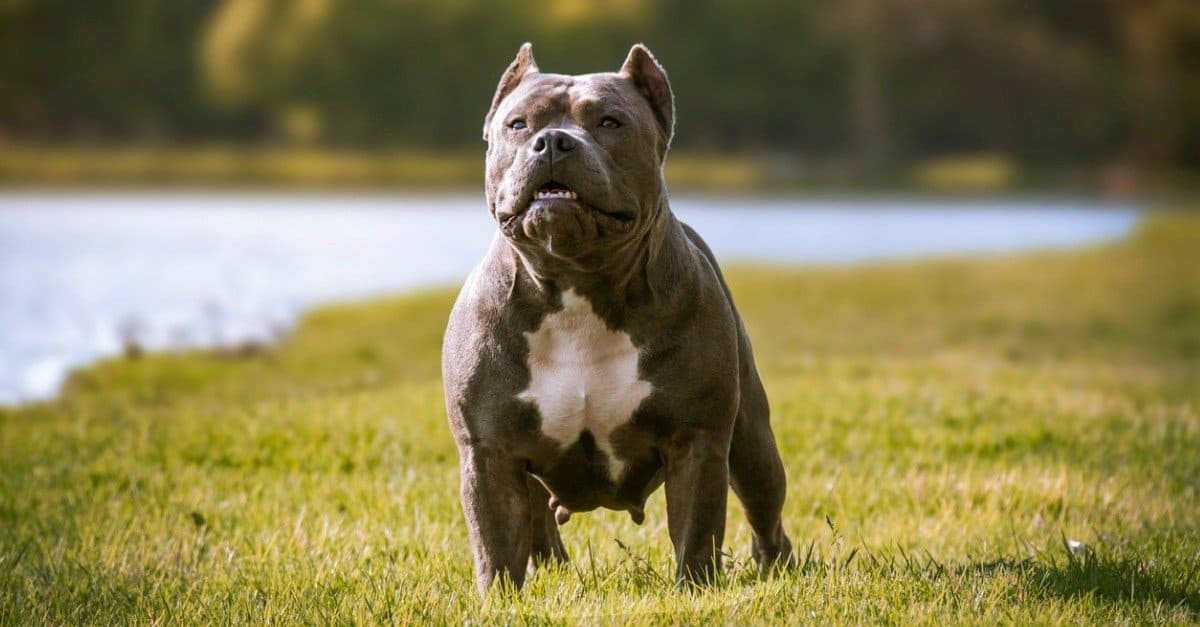
Caring for an American bullterrier is vital for the dog’s health and happiness. Here’s what they need:
- Stick to a regular grooming routine to keep their coat shiny and skin healthy.
- Feed them a nutritious diet that matches their high energy levels, and make sure they get regular check-ups with the vet to catch any health problems quickly.
- Keep them mentally and physically sharp with a solid training schedule and plenty of exercise.
When you look after a Pitbull well, they thrive. Regular grooming stops skin conditions before they start. A good diet and vet visits mean a more robust, happier dog.
Training and exercise are more than just physical. They help your Pitbull feel secure and engaged. A happy Pitbull is a loyal and loving companion.
Basic Grooming Needs
Regular brushing is essential to keep an American bull terrier’s coat in good condition. Their short, stiff fur is easy to manage and doesn’t need much work, so they’re often seen as low-maintenance pets. These dogs have a sleek, glossy coat that naturally stays clean. Even though they’re not heavy shedders, they do lose some hair throughout the year and will shed more as the seasons change, especially in spring and fall.
Baths for your Pitbull should be few and far between, but when they need one, use a gentle shampoo made just for dogs. This helps prevent any skin issues.
It’s also essential to keep their ears clean to stop infections. Check their ears often for signs of trouble like redness, swelling, or a bad smell.
Nutritional Requirements
For the health and upkeep of American Pitbull Terriers, feeding them a balanced diet that includes plenty of quality protein and vital nutrients is crucial. These dogs, which the American Kennel Club recognizes for their strength, need a tailored diet. Their diet must change depending on size, age, activity level, and health.
A well-rounded diet is vital to an energetic and muscular Pitbull Terrier. They must always have fresh water available to stay hydrated. Owners should monitor their dog’s weight and muscle condition, adjusting food and exercise as needed.
Regular check-ups with a vet will help ensure their diet meets their specific needs and keeps them in top shape.
Exercise Regimen
A healthy diet is critical for the well-being of American Pitbull Terriers, but so is a regular exercise routine for their overall fitness and happiness. These energetic dogs need plenty of physical activity, ideally 30 to 60 minutes of intense daily exercise. This helps keep them in top shape and avoids behavior problems.
Due to their inherent agility, these terriers are outstanding in sports and activities that showcase their strength and speed. Mix up their workouts with brisk walks, runs, interactive games, and agility courses for optimal health. These exercises tap into their natural love for movement.
It is also crucial to keep their minds sharp with puzzle toys and consistent obedience training. Regular and varied exercises prevent boredom and promote a well-rounded lifestyle.
Health Check-Ups
Regular health check-ups are essential for American bull terriers to ensure their well-being and long life. These dogs are firm but need regular vet visits to monitor their health.
During these visits, vets should give vaccinations and provide preventative measures against heartworm, fleas, and ticks. These steps are crucial to protect the dog’s health.
Taking care of their teeth is just as important, with consistent brushing and dental exams necessary for good oral health.
Managing their weight is also vital. A balanced diet and regular exercise help prevent issues related to being overweight.
It’s essential to watch for changes in behavior, appetite, or physical condition. If you notice anything unusual, take your pit bull to the vet immediately. This proactive approach helps ensure that these dogs remain energetic and healthy.
Behavioral Training
For American Pitbull Terriers, behavioral training is as vital as regular health check-ups. It’s critical to managing their robust energy and reducing the chance of aggression towards other dogs. We can direct their natural vigor and smarts toward good behavior using positive reinforcement and consistent routines.
Starting socialization and obedience training early is crucial for preventing aggression towards dogs and people.
These actions not only align with breed-specific laws but also help to change how people view these dogs. By training them well, we can show that Pitbulls can be disciplined and friendly. This kind of training also fights against the negative stereotypes often spread by the media. It proves that these dogs can be great companions with the right approach.
Nutritional Requirements
The health and longevity of the American Pitbull Terrier hinge on its diet. Crafting the right meal plan for these dogs should include:
- Balanced nutrition with the right mix of proteins and fats to support their muscular bodies.
- Appropriate vitamins and minerals to suit their age and any health issues they might have.
- Caloric intake should match their activity level to avoid weight gain.
Consulting with a vet specializing in nutrition will help ensure the diet effectively meets these needs.
It’s vital to base these dietary choices on scientific knowledge. Seek advice from a professional in veterinary nutrition to achieve the best results for your pet.
Balanced Diet Essentials
A balanced diet keeps an American Pit Bull Terrier healthy and energetic. Their diet should contain high-quality protein, such as chicken, beef, and fish, to support their muscle growth.
For skin and coat health, include healthy fats like those found in fish oil or flaxseed oil. Carbs from sources like brown rice, sweet potatoes, and various vegetables are essential for these dogs’ high energy levels.
Fruits and vegetables are also crucial as they provide vital vitamins and minerals. Always talk to your vet to customize your Pit Bull’s diet according to their unique needs, including age, activity, and health issues.
It’s best not to give them leftover human food to avoid overfeeding and obesity. Also, ensure they always have access to fresh water to stay hydrated.
Protein and Fat Ratios
A diet supporting their energy and muscle is critical for active American Pit Bull Terriers. You should aim for 25-30% protein and 10-15% fat in their meals. This ensures they have the stamina for their active lifestyle and helps keep their muscles strong. High-quality protein sources like chicken, turkey, and beef are great for them.
Including healthy fats from fish oil and flaxseed will support their overall well-being. If your pit bull is active, sticking to this diet is essential for their endurance and performance.
For the best results, get advice from a vet or a dog nutrition expert to tailor the diet to your dog’s needs.
Vitamins and Minerals Needs
Ensuring the health of American Pit Bull Terriers involves a diet that supports their active nature with the right vitamins and minerals. These dogs thrive on a nutritional plan that includes sufficient amounts of vitamins A, E, and B vitamins and minerals like calcium, phosphorus, and potassium. These nutrients are crucial for maintaining strong bones, proper nerve function, and healthy cells.
For Pit Bull puppies, getting a balance of calcium and phosphorus is essential for their fast-paced growth and bone development. Overdoing or skimping on certain nutrients can cause health problems. It’s best to follow diet experts or a vet created to prevent this. This ensures the dogs get the right amount of nutrients for their age and how much they exercise.

